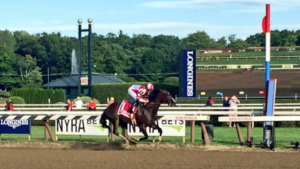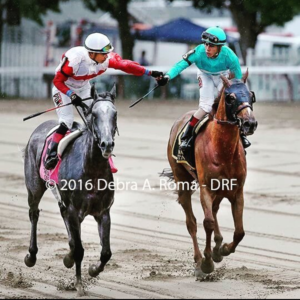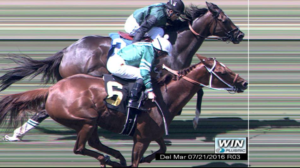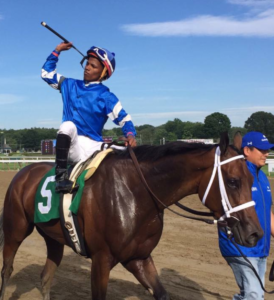
We all know there is an abundance of tools at the handicapper’s disposal today. More than ever before. Some valuable, some essential, some moot, and some worthless. For more of a rundown, I suggest you read the aforementioned column, today we are going to focus on one of the essentials,
BrunowiththeWorks.
Most past performances provide very basic and limited workout information. It borders on obsolete. To know a horse breezed in 49h but not know how he did it, who he did it with, if he did it alone, how he came back, how he looked as opposed to last time he was on the track or worked and more, doesn’t tell you a whole lot that will help with a wagering decision. That is something I think we can almost all agree on.
When it comes to handicapping tools and information, the technology age is automating almost everything it can. In The Sport of Kings however, automation is not as easy as in some other areas. Sure we have algorithms, programs, Trakus with a GPS system, but much of what we analyze is based on human observation. Is there anyone out there who ever saw a trip note they did not agree with? These are human observations and only as good as the person inputting the original data. No matter how good at handicapping you are, or what kind of analyst skills you have, if your raw data is flawed, you are in trouble.
Bruno excels in providing excellent raw data, along with a keen and sharp analysis of it. He also provides it unbiased with a high level of integrity. There are many reasons for this which we’ll discuss.
Bruno De Julio, of BrunowiththeWorks and RacingwithBruno, does not come from the typical racing background. He was an investigator for Pillsbury at Mervyn’s Retail stores in California from Los Angeles down to San Diego for many years. He made over 1500 retail arrests, with not one of them coming back bad. Obviously he has good observatory skills. He transferred those skills and love for thoroughbred racing to The Sport of Kings becoming a handicapper on the John Hernandez radio show. In 1991, he moved to The Racing Times as a clocker, chart caller, and workout analyst. He then spent 19 years as a clocker for Racing Digest. That is a lot of experience, and a lot of watching and studying the thoroughbred and their traits, tells, and body language.
After honing his skills in California for 25 years, which in addition to clocking, charting, handicapping and doing analyst work, included buying and selling horses for partnerships, others, and himself, Bruno went east and started clocking horses there.
Initially he was met with a lot of discouragement, and most of it stemmed from why he went east, and got into clocking in the first place. Bruno’s investigative background caused a lot of skepticism in how the clocking of horses was handled. He was not comfortable with the whole practice, and how it was handled by the racetracks, publications, and clockers. It was not on a par with the level of integrity he felt it should have. If you know Bruno, you know he is passionate and unwavering in what he believes in and is never shy about letting anyone know exactly what that is. He was determined to make a difference.
Bruno started clocking and handicapping for Grade 1 Racing and ultimately started Bruno with the Works in 2012. He focused on making sure he properly identified the horse he was clocking, in addition to all the observatory skills he developed over the years. He brought clocking to a new level of accountability and accuracy, and forced integrity into the picture at a higher level. What he saw was what you got, and it was accurate.
As with anything involving money, accountability and credibility almost always become an issue. Bruno tried to erase that concern from his chosen profession, where it seemed to be almost an inherent problem. That’s not to say there aren’t other honest and credible clockers out there, there certainly are, but Bruno is the one who tackled the concerns of the art head on. He built his reputation on putting his money where his mouth was, whether it was clocking, betting, or buying horses. He called it the way he saw it and never went the “popular” route for the sake of making friends. He wanted his product to speak for itself, and the rest would take care of itself.
We all can chose what tools we want in our arsenal. If you don’t think having detailed and accurate workout information is a value, that tells you how a horse worked, not just the time, with who, how it compares to other works, trainer work patterns, and more, that is certainly your prerogative. I think it’s a valuable tool, and I am of the philosophy, “give me the information, and I’ll decide what to do with it”. Bruno provides information.
In addition to what is likely the most comprehensive workout reports, including ratings of works, Bruno provides handicapping analysis and selections with suggested wagers. He also provides sales and auction histories, pedigree analysis, and a comprehensive workout database. The newest feature is his “Delta Figs” which were in development for three years. Delta Figs are not speed figures and differ from most figures offered today. While most figures provide a grading of a horses past races, Delta Figs provide a gauge of what a horse will likely do today based on handicapping principles employed by Bruno. The lower the figure the better, but again it’s a projection of what the horse is expected to do today.
What really matters to the bettor is how easy is this information to decipher, and how valuable does it turn out to be. I’ve been watching and using Bruno’s information a long time. Being a student of the game, and having a preference for having all the “valid” and “legitimate” information at my disposal prior to wagering, I find the workout reports essential.
Another thing that separates Bruno and his staff from many other sources of handicapping information, is the consistency of the product from track to track. Bruno trains all his clockers diligently, and with the same attention to detail he has. When you compare tracks, it is hard to differentiate who is doing the work. It is a team effort.
What many handicappers don’t realize is knowing a horse is over bet, overrated, or just not as talented as it appears is just if not more valuable than knowing one is well meant. This is never more true than in maiden races, and especially in maiden special weight races at the premier meets. An example that comes to mind is Marking at Saratoga last year. Marking was touted by most clockers and just about anyone else with an opinion as a very good and fast horse. A win first out was pretty much a given in the eyes of many. Now granted, Marking is a very nice stakes caliber horse, and this is precisely what makes Bruno’s information and eyes all the more valuable. He was the only one I recall saying Marking was a flat out bet against in his debut. Bruno knew he was high strung and quirky, especially at the gate, and that he didn’t shut down, making a debut win all the less likely. Carrying a ton of money on his back, Marking freaked out at the gate and was scratched. His backers likely lucked out, as had he run he probably would have gotten beaten that day. This is the kind of information that pays for itself. While Marking has become a nice horse, his quirks have remained with him, probably stopping him from reaching his full potential.
We all know racing is about what have you done for me lately, so we’ll look at some recent results from opening Saturday at Saratoga. I can mention horses from the past years all day long, but what does that have to do with here and now is what many will say.
The Sanford on Saturday was a race made up of mostly horses who ran once, on different days and tracks. That is a more challenging handicapping scenario, and makes workout information all the more valuable. Bruno had one horse with a 4-star **** work going in, and he was also tied for the best Delta Fig. The results speak for themselves.
![]()
Bitumen
Big Rock was another winner with the lowest Delta Fig. Again you can see the observations right here.

Another race where workout observations and a keen eye helped was the maiden special weight race won by One Liner. A flat out runner per Bruno and his workout observations. This detailed analysis is not something you will find anyplace else.

On Sunday you saw something that you just won’t see anywhere else. It’s the kind of information you can really capitalize on, and really give yourself an edge. In the 4th race, a New York Bred maiden special weight race, the #7, Woodville was listed as the first ever starter for Jorge Abreu. The $100,000 Ghostzapper filly was actually training in Chad Brown’s colors, and with Chad’s horses. She took smart late money going off at 5-2, and delivered an eye catching open length victory under wraps. That’s a clocker report.


When considering the tools for your arsenal, consider the source, the integrity, and the expertise. The better your ammunition, the better your chance to win the war and have an edge. Bruno provides an edge.
High Five
Songbird was simply awesome. She finally got hooked and headed, by a quality horse in Carina Mia, and responded with heart. She opened up again, and still won throttled down. Wow!

Songbird at Saratoga
Irad Ortiz Jr. announced his intention of repeating his Saratoga riding title by winning 4 races opening day.
[/
Irad congratulated by brother Jose
Meanwhile out west at Del Mar, Norberto Arroyo Jr., a former New York mainstay, announced his return to the big time with a win early in the meet out riding perennial leading rider Raphael Bejarano. Here is the picture of the photo, maybe it came down to desire, as nobody can question either rider’s talent.

Ricardo Santana Jr. gets a high five for a three bagger at The Spa his fourth day there in his first full meet.

Low Five
I found it odd when Larry Collmus reportedly gave up his spot at The Gulfstream Championship Meet, a meet which helped propel him onto the national stage, Triple Crown, and NYRA. I love Larry’s calls but noticed the other day he called a filly a colt, and he has been calling horses on the lead before they get there, and that’s just not like him. Maybe something is going on that is not public, or maybe Larry is in a slump, to which he’d be entitled. But Low Five, can’t be calling fillies colts at The Spa, or horses surging to the front when they are still in second. It wasn’t as bad as two weeks ago when Michael Wrona said he’s not going to make it, just before he got up.




